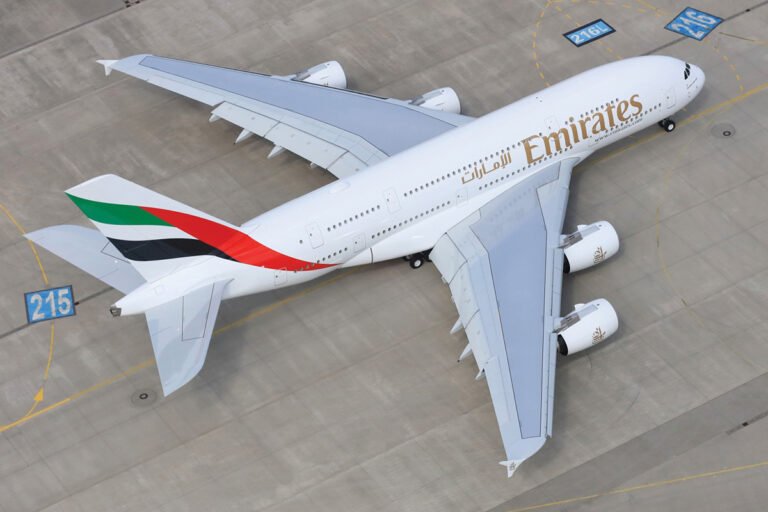Emirates buys Airbus A380s four of them from Nimrod Air Three in a significant $180 million move that underscores the airline’s long-term commitment to the superjumbo fleet. This strategic purchase has not only surprised aviation enthusiasts but also reaffirmed Emirates’ position as the largest operator and supporter of the Airbus A380 in the world.
In this article, we explore what this deal means for Emirates, the global aviation industry, and the future of the iconic A380 aircraft. Let’s take a closer look at the background of the deal, why Emirates decided to buy these aircraft, and how this fits into the airline’s broader vision.
The background: Emirates and the Airbus A380
When people think of the Airbus A380, the first name that comes to mind is Emirates. The Dubai-based airline is synonymous with this giant aircraft, which is beloved by passengers for its spaciousness and luxury.

Emirates has been the largest customer of the A380 since it was introduced. Out of the 251 A380s produced by Airbus, Emirates alone ordered 123. The A380 has played a central role in Emirates’ strategy to connect global cities via its Dubai hub, offering high-capacity flights and unmatched onboard comfort.
However, the COVID-19 pandemic in 2020 led many airlines to retire their A380 fleets early, citing high operational costs and a sharp decline in international travel. But Emirates stood firm. The airline continued to invest in and operate the A380, betting on a rebound in long-haul premium travel.

The Nimrod connection
Nimrod Air Three, a UK-based investment fund specializing in aircraft leasing, originally owned these four A380s. Emirates had been leasing them for years as part of its extensive A380 fleet operations.
Aircraft leasing is a common practice in aviation. It allows airlines to operate planes without large upfront costs, giving them flexibility in managing fleets. However, at the end of a lease, airlines often face choices: return the aircraft, renew the lease, or purchase it outright.
In this case, Emirates decided to acquire the four aircraft permanently for $180 million. The deal’s completion signals that Emirates wants to lock in these valuable assets as part of its future growth plans.
Why did Emirates decide to buy these A380s?
Long-term fleet stability
By purchasing these A380s, Emirates gains full control over the aircraft without lease-related restrictions. This allows them to plan long-term maintenance schedules, cabin refurbishments, and route strategies with more flexibility.
Cost advantages
Leasing can become expensive over time. With rising interest rates and inflation impacting leasing costs globally, owning aircraft outright can lead to substantial cost savings in the long run. Emirates’ $180 million purchase may appear large, but it likely translates to lower lifetime operational costs compared to renewing leases.
Commitment to premium passenger experience
Emirates is famous for its luxurious onboard products — from first-class suites to onboard showers and lounges. The A380 is central to delivering these experiences at scale. By owning more A380s, Emirates reinforces its promise to offer a premium flying experience that sets it apart from competitors.
Market confidence
This deal signals confidence in long-haul international travel demand, especially in premium cabins. As global travel recovers and airports get busier, the A380’s high capacity makes it ideal for busy routes such as Dubai to London, Sydney, or New York.

Emirates’ strategy: doubling down on the A380
While many airlines have moved toward smaller, more fuel-efficient twin-engine aircraft like the Boeing 787 and Airbus A350, Emirates has chosen a hybrid strategy. It continues to expand its fleet of new-generation aircraft but has kept the A380 as its flagship for high-demand routes.
This strategy aligns with Dubai’s growth as a mega transit hub. High-capacity aircraft help Emirates maintain its competitive advantage, offering more seats per flight and supporting Dubai’s vision of becoming the world’s busiest international airport.
The financial side: breaking down the $180 million deal
At first glance, $180 million for four A380s might seem like a bargain, especially considering that a new A380 had a list price of around $445 million each when production ended.
However, it’s important to understand that aircraft values depreciate over time. Factors like age, maintenance records, and future demand affect pricing. The four A380s in question are several years old, and with no new A380s being produced, the resale market is limited.
By buying these aircraft at this price point, Emirates likely secured favorable terms, reflecting both the age of the jets and the specialized nature of the A380 market.
Impact on passengers
For passengers, this move is positive news. Emirates’ continued investment in the A380 means travelers can expect to enjoy this unique aircraft for many years to come. The spacious cabins, quiet ride, and luxurious onboard features have made the A380 a favorite among frequent flyers.
The airline has also announced plans to continue retrofitting older A380s with new interiors and updated products. Owning more aircraft outright allows Emirates to control refurbishment timelines better and introduce new customer experiences without leasing limitations.
Industry reaction: a bold but risky move?
While many in the aviation industry see this as a bold affirmation of the A380, some analysts have expressed caution. The A380 is expensive to operate and maintain compared to smaller wide-body aircraft. Moreover, airports must be specially equipped to handle it, limiting its operational flexibility.
However, Emirates’ hub-and-spoke model is uniquely suited to high-capacity aircraft. Instead of flying many smaller aircraft to multiple destinations, Emirates focuses on funnelling global passengers through its Dubai hub on larger planes. This model works exceptionally well for them and has kept the A380 viable in their network.
What this means for Airbus
Airbus officially ended A380 production in 2021 due to declining orders. Emirates was, in fact, the last customer to receive new A380s. This recent purchase doesn’t directly impact Airbus’ production line but reaffirms that there is still life left in the existing A380 fleet.
It also signals to other operators and leasing companies that Emirates remains deeply invested in this aircraft type, potentially giving residual A380 values a small boost.

Future of the A380 fleet at Emirates
Emirates currently operates about 90 A380s and has gradually retired some older units. With this purchase, Emirates secures a core part of its fleet for at least another decade.
The airline has announced plans to keep flying the A380 into the 2030s, focusing on high-demand routes. Emirates’ President, Sir Tim Clark, has been a vocal supporter of the A380, and this purchase aligns with his long-standing strategy.
Environmental considerations
One criticism of the A380 has been its environmental footprint. The aircraft is heavier and consumes more fuel than newer twin-engine jets. However, Emirates has made efforts to improve its environmental performance by:
- Implementing lighter cabin materials during refurbishments
- Using more efficient engines and wing modifications where possible
- Investing in sustainable aviation fuels (SAF) and carbon offset programs
By optimizing how the A380 is used (such as ensuring high load factors), Emirates aims to balance its environmental impact with its operational needs.
The leasing market: lessons from the deal
This purchase highlights a broader trend in the leasing industry. As interest rates rise and capital becomes more expensive, airlines might increasingly prefer to own rather than lease, especially for key fleet types.
Leasing remains popular for flexibility and cash flow management, but ownership offers long-term cost certainty and control. Emirates’ decision could influence other airlines to reassess their fleet financing strategies, particularly for specialized aircraft types.
Looking ahead: Emirates’ fleet beyond 2030
Emirates has a diverse fleet strategy. Besides the A380, it operates Boeing 777s and has orders for new-generation aircraft, including the Boeing 787 Dreamliner and Airbus A350. These smaller, more efficient aircraft will serve thinner routes and complement the A380 on flagship services.
This blended approach allows Emirates to match aircraft size to route demand, maximize efficiency, and maintain its premium brand image globally.
A symbolic and strategic purchase
In many ways, this $180 million deal is more than a transaction; it is symbolic. Emirates is making a statement to the world: the A380 remains core to its identity and long-term success.
While many airlines have retreated from large aircraft, Emirates doubles down, betting on a future where travelers will continue to value comfort, space, and direct connectivity via Dubai.
Conclusion
Emirates buys Airbus A380s from Nimrod Air Three for $180 million in a move that is both bold and strategic. This purchase strengthens its superjumbo fleet and underscores the airline’s unwavering commitment to luxury and high-capacity travel.
As travel rebounds, Emirates positions itself to capture premium travelers and maintain its dominance as a global connector. Passengers can look forward to seeing — and flying — the iconic A380 for many years to come, thanks to this landmark deal.
Do follow UAE Stories on Instagram
Read More: Mubadala acquires Techem in $7.9bn deal, joins new consortium














